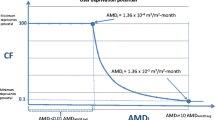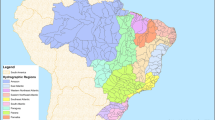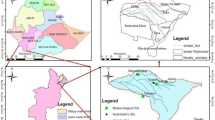Abstract
Purpose
Despite recommendations, uncertainty results are rarely incorporated in Life Cycle Assessment (LCA) studies, especially regarding characterization factors (CF). Part 1 of this study conducted AWARE CF regionalization for Brazil, concluding that the Semiarid region had maximum scarcity values. The goal of this study is to evaluate the uncertainties of regionalized AWARE CF in the Semiarid region.
Methods
Data used to obtain the AWARE BR CF for Brazil were qualitatively and quantitatively assessed. An adapted Pedigree Matrix was adopted to assess qualitative uncertainties. Classical statistical analysis was used for quantitative uncertainty assessment, and 10,000 Monte Carlo simulations were computed for uncertainty propagation.
Results and discussion
Qualitative results indicated that the natural flow’s parameter was very uncertain due to poor spatial correlation and low reliability, as it is based on empirical models. Quantitative results showed that water availability data, which had large temporal variability, typical of the Brazilian Semiarid region, was the main responsible for uncertainties in input data. Area uncertainty had a good performance in both qualitative and quantitative assessments. Regarding output data, moderate CF were found to be more uncertain, while more extreme CF exhibited lower variation, corroborating with previous analyses. Moreover, the adoption of shorter datasets led to a reduction in average and standard deviation values for CF.
Conclusion
Findings from this study showed two important reasons why the quantitative and qualitative assessments should be conducted simultaneously. The first one was to avoid bias, as availability data and natural flow performed differently in each evaluation. The second one was to confirm results, as the area proved to be very little uncertain in both assessments. An adaptation of Pedigree Matrix and a penalty factor for missing data could be used as a base for quantitative uncertainty parameters for LCIA. Generating SD and k-factor was very positive in terms of results for AWARE method and comparison with other methods. Both indicators had similar results and led to a common conclusion: uncertainties are mainly low and very low for AWARE BR CF in the Semiarid region.










Similar content being viewed by others
References
Agência Nacional de Águas (2016). Nota Técnica n° 16/2016/SPR. Brasília, DF
Alves KF, Ugaya CML. (2018) Incertezas em AICV: estado da arte [Uncertainties in LCIA: state of the art]. In: VI Congresso Brasileiro sobre Gestão de Ciclo de Vida
Andrade EP, Nunes ABA, Alves KF, Ugaya CML, Costa MA, Santos TL, Barros VS, de Figueiredo MCB (2019) Water scarcity in Brazil: part 1—regionalization of the AWARE model characterization factors. Int J Life Cycle Assess:1–17
Björklund AE (2002) Survey of approaches to improve reliability in LCA. Int J Life Cycle Assess 7(2):64–72. https://doi.org/10.1007/BF02978849
Boots BN (1986) Voronoi (Thiessen) polygons. Geo Books
Boulay AM, Bare J, Benini L et al (2018) The WULCA consensus characterization model for water scarcity footprints: assessing impacts of water consumption based on available water remaining (AWARE). Int J Life Cycle Assess 23(2):368–378. https://doi.org/10.1007/s11367-017-1333-8
De Schryver AM, Goedkoop MJ, Leuven RSEW et al (2010) Uncertainties in the application of the species area relationship for characterisation factors of land occupation in life cycle assessment. Int J Life Cycle Assess 15(7):682–691. https://doi.org/10.1007/s11367-010-0205-2
Dean RB, Dixon WJ (1951) Simplified statistics for small numbers of observations. Anal Chem 23(4)
Hair JF, Black WC, Babin BJ, Anderson RE (1998) Multivariate data analysis, 5th edn. Pearson, Upper Saddle River
Hedbrant J, Sörme L (2001) Data vagueness and uncertainties in urban heavy-metal data collection. Water Air Soil Pollut Focus 1(3):43–53
Huijbregts MA (1998) Application of uncertainty and variability in LCA. Int J Life Cycle Assess 3(5):274–280. https://doi.org/10.1007/BF02979835
Igos E, Benetto E, Meyer R, Bausters P, Othoniel B (2019) How to Treat Uncertainties in Life Cycle Assessment Studies? Int J Life Cycle Assess 24:794–807. https://doi.org/10.1007/s11367-018-1477-1
ISO 14040 (2006) International standard. Environmental Management - Life Cycle Assessment - Principles And Framework
ISO 14044 (2006) International standard. Environmental Management - Life Cycle Assessment-Requirements and Guidelines
Meier MA (1997) Eco-efficiency evaluation of waste gas purification systems in the chemical industry. Eco-Informa Press, Bayreuth
Núñez M, Pfister S, Vargas M, Antón A (2015) Spatial and temporal specific characterization factors for water use impact assessment in Spain. Int J Life Cycle Assess 20(1):128–138. https://doi.org/10.1007/s11367-014-0803-5
Pastor AV, Ludwig F, Biemans H, Hoff H, Kabat P (2013) Accounting for environmental flow requirements in global water assessments. Hydrol Earth Syst Sci Discuss 10(12):14987–15032. https://doi.org/10.5194/hess-18-5041-2014
Pfister S, Hellweg S. (2011) Uncertainty in characterization factors of water consumption impacts on water scarcity (midpoint) & human health (endpoint) including variability-induced uncertainty of spatially aggregated characterization factors. In: LC-Impact project report
Pfister S, Koehler A, Hellweg S (2009) Assessing the environmental impacts of freshwater consumption in LCA. Environ Sci Technol 43(11):4098–4104. https://doi.org/10.1021/es802423e
Ross S, Evans D, Webber M (2002) How LCA studies deal with uncertainty. Int J Life Cycle Assess 7(1):47. https://doi.org/10.1007/BF02978909
Roy PO, Azevedo LB, Margni M, van Zelm R, Huijbregts MA (2014) Characterization factors for terrestrial acidification at the global scale: a systematic analysis of spatial variability and uncertainty. Sci Total Environ 500–501:270–276. https://doi.org/10.1016/j.scitotenv.2014.08.099
SETAC (1997) Life-cycle impact assessment: the state-of-the-art
Slob W (1994) Uncertainty analysis in multiplicative models. Risk Anal 14(4):571–576. https://doi.org/10.1111/j.1539-6924.1994.tb00271.x
Sonnemann GW, Schuhmacher M, Castells F (2003) Uncertainty assessment by a Monte Carlo simulation in a life cycle inventory of electricity produced by a waste incinerator. J Clean Prod 11(3):279–292. https://doi.org/10.1016/S0959-6526(02)00028-8
Steffen W, Richardson K, Rockström J, Cornell SE, Fetzer I, Bennett EM, Biggs R, Carpenter SR, Vries W, Wit CA, Folke C, Gerten D, Heinke J, Mace GM, Persson LM, Ramanathan V, Reyers B, Sörlin S (2015) Planetary boundaries: guiding human development on a changing planet. 347(6223). https://doi.org/10.1126/science.1259855
UNEP SETAC (2016) Global guidance for life cycle assessment indicator
Weidema BP, Wesnaes MS (1996) Data quality management for life cycle inventories—an example of using data quality indicators. J Clean Prod 4(3–4):167–174. https://doi.org/10.1016/S0959-6526(96)00043-1
Wender BA, Prado V, Fantke P, Ravikumar D, Seager TP (2018) Sensitivity-based research prioritization through stochastic characterization modeling. Int J Life Cycle Assess 23(2):324–332. https://doi.org/10.1007/s11367-017-1322-y
Acknowledgments
The results of this study were part of the research activities developed in the Center for Life Cycle Sustainability Assessment (Gyro) at the Federal University of Technology Paraná, and it was linked to the Brazilian Life Cycle Impact Assessment Research Network (RAICV) that includes specialists from educational and private institutions. We would like to acknowledge the National Water Agency (Agência Nacional de Águas—ANA) for providing the information needed for this study.
Funding
The National Council for Scientific and Technological Development (Conselho Nacional de Desenvolvimento Científico e Tecnológico—CNPq) provided financial support.
Author information
Authors and Affiliations
Corresponding author
Additional information
Communicated by Marisa Vieira
Publisher’s note
Springer Nature remains neutral with regard to jurisdictional claims in published maps and institutional affiliations.
Rights and permissions
About this article
Cite this article
Alves, K., Andrade, E.P., Savioli, J.P. et al. Water scarcity in Brazil: part 2—uncertainty assessment in regionalized characterization factors. Int J Life Cycle Assess 25, 2359–2379 (2020). https://doi.org/10.1007/s11367-020-01739-3
Received:
Accepted:
Published:
Issue Date:
DOI: https://doi.org/10.1007/s11367-020-01739-3




